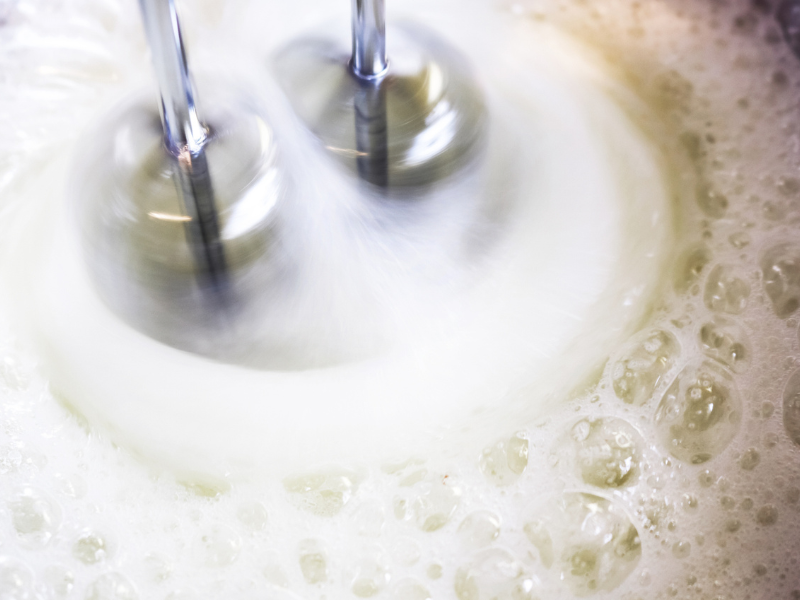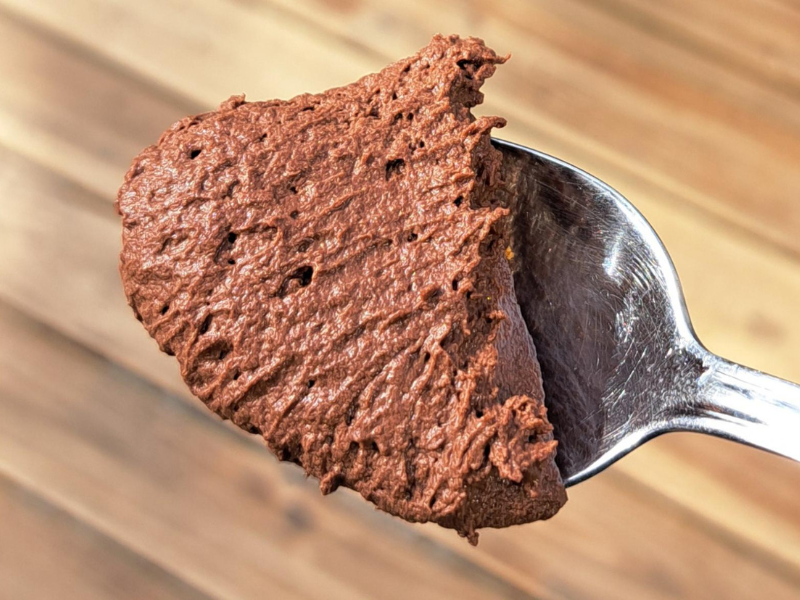The Science Behind Chocolate Mousse
Ooh, yummy chocolate mousse! Silky, sumptuous, simplicity at its finest. It looks straightforward enough, but is it?
Anatomy of a Mousse
If you’re going to make a mousse, you’re going to need little bubbles of air. Then you’ll need to fold them into ingredients that need to be somewhat liquid. Little bubbles occasionally appear all on their own at the surface of other liquids, like hot chocolate or soda pop, but they dissipate and don’t usually stick around for very long. The secret to a mousse is knowing how to trap those little bubbles so they can do their magic.
We’re talking about chocolate mousse here, so let’s start with the chocolate. Since all our mousse ingredients need to be somewhat liquid, the chocolate needs to be melted. This is critical if you want every part of your chocolate to contain those bubbles, and if you’re making mousse that’s exactly what you want! Since “mousse” is a French word for froth, the next step is to froth the other ingredients going into your mousse, like eggs or cream. This is usually done by whipping them with a whisk or a frother. The idea is to create as many bubbles as possible. This is what gives the mousse that light and airy texture. Once everything is nice and frothy, you simply mix in the melted chocolate and ta-dah, chocolate mousse! But wait, how does a mousse manage to keep those bubbles of air from dissipating? It’s thanks to the fatty or protein-rich ingredients. Let’s look at why those fats and proteins are so important.
Fat Particles
By whipping the cream, you’re also whipping the fat particles found in it, and these whipped fat particles are what helps trap the bubbles of air. Ah-ha, but there’s a hitch! If you want those bubbles to stay trapped, the cream must be cold. As you may have noticed, if you leave whipped cream out at room temperature, it will eventually go flat. Keeping it cold in the refrigerator is how you keep it whipped in shape. That's because the cream's fat content solidifies in the cold and becomes stiff. Those stiffened fat particles wrap themselves around the bubbles of air and trap them. Back to our chocolate mousse now: Did you know that chocolate also contains fat? That means it also stiffens when it is refrigerated, so chocolate also helps keep those bubbles of air trapped in the mousse.
Then there are egg yolks, an ingredient often found in mousse recipes. These also contains fat. They also contain lecithin. Naturally occurring lecithin, the kind found in egg yolks, also acts as a thickener. That means that using egg yolks also helps stiffen your ingredients. It also helps give chocolate mousse that nice, silky texture.
Protein

Protein, like the kind you find in egg whites, can also trap bubbles of air. At the molecular level, proteins are twisted but they unravel when they get whipped. When they unravel, the molecules turn into a kind of film that can trap those little bubbles of air. The more you whip them, the more air bubbles get trapped, and the fluffier the egg whites get. Whip them long enough and they become stiff and form small peaks. Those peaks are your cue that those egg whites are full of bubbles and that they are ready to be added to the melted chocolate in your mousse recipe.
Look Mom! No Cream! No Eggs!
Traditional chocolate mousse recipes contain eggs and cream, but there are all sorts of alternative chocolate mousse recipes: just with egg whites, just with cream, with or without gelatin, with or without sugar added, vegan with avocado, vegan with coconut cream, or vegan with aquafaba.
So, here's a question: Think it might be possible to make chocolate mousse just with chocolate and water? Answer: Yes! This was discovered by French chemist and the father of molecular cooking Hervé This. The idea dawned on him when he realized that, apart from its diluted fat, cream is mostly water.
As we saw earlier, when cream is cold whipped (in a frosty bowl, for instance), the air bubbles that result stay trapped because the cream’s fat gets stiff as it cools. Since chocolate already contains fat (in the form of cocoa butter), Hervé This realized that you could simply add water to the chocolate and that whipping them together would create bubbles and the fat in the chocolate would do the work of trapping them. It also helps that chocolate often contains lecithin too (yes, the same kind found in egg yolks). Lecithin helps give this water-only chocolate mousse that nice, even texture. Chemist Hervé This was the first to realize that chocolate already has everything you need to make a mousse. Just add water!
Really? Just Water? But How?

Any cook will tell you that you should avoid mixing melted chocolate and water because it makes the chocolate grainy, lumpy, and difficult to work with. Ah, but what if you use boiling water? When adding nearly equal parts boiling water to chocolate, the fat in the chocolate gets diluted and becomes smooth, not lumpy. That’s because using very hot water melts the chocolate into a light, smooth liquid, as opposed to the thick gooey liquid you get from melting chocolate on its own.
For this kind of mousse recipe, you would use dark chocolate with at least 65% of cocoa content. Why dark chocolate? Because it contains more cocoa butter, which means it contains more fat, which is what you need to trap the air bubbles. By whipping the boiling water and the chocolate together in a refrigerated bowl (a bowl sitting on ice cubes), this recipe takes advantage of the magic made possible when fat is cooled and stiffens. Thanks to the cold, the liquified fat in the chocolate re-stiffens and traps those little bubbles of air your mousse needs.
Now that you know the basics behind making chocolate mousse, it's time to try different recipes and figure out which one you like best! All in the name of science, of course!
Hungry for more food science? Don’t miss the interactive exhibition Banquet at the Montréal Science Centre.
Sources :
L’œuf et ses pouvoirs : Un peu de science en cuisine !
https://gabriel-pastry-art.fr/l-oeuf-et-ses-pouvoirs-un-peu-de-science-en-cuisine/?fbclid=IwZXh0bgNhZW0CMTAAAR05XyWFQWAhEuc8c8LsKGxVGT1xkPByFWlVN79kQMNUYfB0PsVBXNa9Tf0_aem_Ab4U27fWQACTLMhGAQOh-MakKj9wuf5LVbB6H2wNuVKiK6iN2wYcfJk0-YcPFBTFGmbUKPHfZPVomLke99cggD39
How to Make Chocolate Mousse (Science of Stabilizing Foams)
https://foodcrumbles.com/chocolate-mousse-stabilizing-foam/
Science of cooking - Culinary Foams https://www.scienceofcooking.com/foams/culinary_foams.htm
The Science of Dark Chocolate Mousse
https://blogs.dickinson.edu/chemistryinthekitchen/recipes/dark-chocolate-mousse/
Chocolate + Water = Mousse?
https://www.seriouseats.com/chocolate-plus-water-equals-mousse
Terminologie; qu’est-ce qu’une émulsion ? par Hervé This
https://nouvellesgastronomiques.com/terminologie-quest-ce-quune-emulsion-par-herve-this/
This 1-Ingredient Chocolate Mousse Is a Miracle of Science https://www.epicurious.com/recipes-menus/herve-this-chocolate-and-water-mousse-science
Mousse au chocolat: nos 10 meilleures recettes à vie!
https://www.pratico-pratiques.com/galeries-thematiques/mousse-au-chocolat-nos-10-meilleures-recettes-a-vie/
Recette traditionnelle de mousse au chocolat
https://ici.radio-canada.ca/mordu/recettes/1715/mousse-chocolat-traditionnel
Recette Harvé This en vidéo : 2 Ingredient Chocolate Mousse (Chocolate + Water)
https://youtu.be/zGfpxQ2Idnw?si=-POhdNrwjR7ZSjIT
Recette Harvé This en vidéo : Heston Blumenthal's Mousse Masterclass
https://youtu.be/F6oMIo3GTQ8?si=LlvB_J0nieXIG6IK
Livre : Molecular Gastronomy: Exploring the Science of Flavor, par Hervé This, Columbia University Press, 2008
Livre : Le Grand Larousse gastronomique, présidé par Joël Robuchon, Éditions Larousse, 2017
